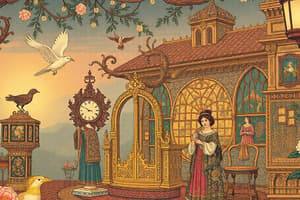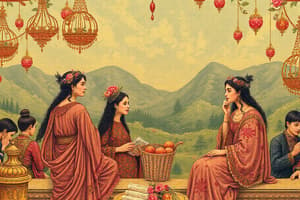Podcast
Questions and Answers
How do cultures typically change over time?
How do cultures typically change over time?
- They evolve based on adjustments to the prevailing environment. (correct)
- They remain the same regardless of external influences.
- They change primarily due to technological advancements.
- They are static and do not adapt to new environments.
What is the primary difference between subcultures and countercultures?
What is the primary difference between subcultures and countercultures?
- Countercultures exist within the larger culture without opposition.
- Subcultures are larger than countercultures.
- Subcultures share core beliefs with the dominant culture while countercultures deliberately oppose it. (correct)
- Countercultures accept all aspects of the dominant culture.
What does the term 'ethnocentrism' refer to?
What does the term 'ethnocentrism' refer to?
- The acceptance of all cultural practices as equally valid.
- The ability to understand a culture from its own perspective.
- The belief that one's own culture is superior to others. (correct)
- The spread of cultural elements across different societies.
Which of the following best defines cultural relativism?
Which of the following best defines cultural relativism?
Which of the following statements about cultural diffusion is true?
Which of the following statements about cultural diffusion is true?
How does innovation contribute to culture?
How does innovation contribute to culture?
In the context of culture, what are 'cultural universals'?
In the context of culture, what are 'cultural universals'?
What is the primary focus of anthropology?
What is the primary focus of anthropology?
What is considered non-material culture?
What is considered non-material culture?
Which of the following best defines society?
Which of the following best defines society?
What does the term 'politics' refer to in the context of organized institutions?
What does the term 'politics' refer to in the context of organized institutions?
How is ethnicity defined in this context?
How is ethnicity defined in this context?
What is the significance of nationality in relation to identity?
What is the significance of nationality in relation to identity?
Which aspect is NOT typically associated with culture?
Which aspect is NOT typically associated with culture?
Which of the following elements contributes to exceptionality in an individual?
Which of the following elements contributes to exceptionality in an individual?
What role does religion play in culture according to the provided content?
What role does religion play in culture according to the provided content?
What is the definition of cultural relativism?
What is the definition of cultural relativism?
Which of the following describes the process of diffusion in cultural change?
Which of the following describes the process of diffusion in cultural change?
Which term describes norms that are specifically written down and associated with strict punishments?
Which term describes norms that are specifically written down and associated with strict punishments?
What best defines cultural shock?
What best defines cultural shock?
What do we call a culture that deliberately opposes the larger culture?
What do we call a culture that deliberately opposes the larger culture?
Which concept refers to the idea that cultural ideas do not keep pace with social changes?
Which concept refers to the idea that cultural ideas do not keep pace with social changes?
What is an example of material culture?
What is an example of material culture?
Which of the following best defines sanctions in a cultural context?
Which of the following best defines sanctions in a cultural context?
What does ethnocentrism imply about a person's view of their own culture?
What does ethnocentrism imply about a person's view of their own culture?
Which characteristic of culture indicates that it is acquired through learning and experience?
Which characteristic of culture indicates that it is acquired through learning and experience?
What is the term for a newly created idea or object that is introduced into a culture?
What is the term for a newly created idea or object that is introduced into a culture?
Which aspect of culture refers to the shared ideas and norms that guide behavior?
Which aspect of culture refers to the shared ideas and norms that guide behavior?
What type of norms are generally understood but not precisely recorded?
What type of norms are generally understood but not precisely recorded?
Which of the following is likely to result from cultural variation?
Which of the following is likely to result from cultural variation?
Study Notes
Culture
- Culture is cumulative; it builds on existing knowledge and evolves over time.
- Technology profoundly alters cultural aspects, potentially shaping future generations.
- No culture is static; it continually adjusts to environmental changes.
- Cultural diversity reflects unique customs and practices across the globe.
- Shared culture fosters group identity and societal coherence.
- Language acts as both a reflection and a shaper of culture.
- Norms are categorized into formal (written rules) and informal (understood behaviors).
- Innovation drives cultural expansion through discovery (sharing new knowledge) and invention (combining existing items).
- Cultural diffusion spreads cultural elements globally, yet resistance often arises against foreign ideas perceived as threats to values.
Subcultures and Countercultures
- Subcultures exist within a larger culture and reflect specific beliefs or practices.
- Countercultures actively oppose aspects of the dominant culture.
- Ethnocentrism is the belief in the superiority of one’s own culture, which can lead to intolerance.
- Cultural relativism emphasizes understanding behaviors within the context of their own culture.
Anthropology
- Derived from Greek “Anthropos” (humans) and “Logos” (study), anthropology focuses on human and cultural evolution.
- Anthropologists embrace diversity to comprehend community dynamics and identify cultural universals like marriage and ceremonial practices.
Political Science
- Examines the state, focusing on power dynamics in social, political, and cultural contexts.
- Political analysis spans local to international levels and evaluates government structures and societal behavior.
Cultural Elements
- Material Culture: Tangible objects like food, clothing, and art.
- Non-material Culture: Intangible elements such as values, beliefs, and norms.
- Language serves as a system of symbols for communication, influencing thoughts and behaviors.
- Norms dictate appropriate conduct, either formal with strict penalties or informal and understood.
- Sanctions are rewards or penalties associated with social norms.
Cultural Change and Innovation
- Cultural change occurs through innovation, either through invention or discovery.
- Diffusion allows cultural exchange via exploration, conquest, or media.
- Cultural lag happens when existing norms cannot meet new societal dynamics, leading to disjunction.
Characteristics of Culture
- Culture is learned through experiences, training, and observation.
- It is shared among groups providing unity and identity.
- Culture is dynamic, meaning it evolves and adapts continuously.
- It reflects diversity, exhibiting different beliefs and practices globally.
Social Factors
- Gender: Cultural expressions can vary significantly by gender role expectations.
- Nationality: Shared history and traditions shape group identity.
- Religion: Organizes spiritual beliefs and practice structures influencing culture.
- Socioeconomic Status: Drives cultural access and expression.
- Exceptionalities: Acknowledges diverse abilities within cultural contexts.
Attitudes Toward Cultural Variation
- Ethnocentrism: Leads to negative behaviors like discrimination and intolerance.
- Xenocentrism: Valuing foreign cultures over one’s own.
- Cultural Relativism: Encourages understanding and respect for different cultural practices.
Studying That Suits You
Use AI to generate personalized quizzes and flashcards to suit your learning preferences.
Related Documents
Description
Explore the concept of culture as a cumulative and dynamic phenomenon. This quiz delves into how technology influences cultural changes and highlights the diversity of cultures worldwide. Discover how shared experiences shape group identities and the ever-evolving nature of cultural practices.




